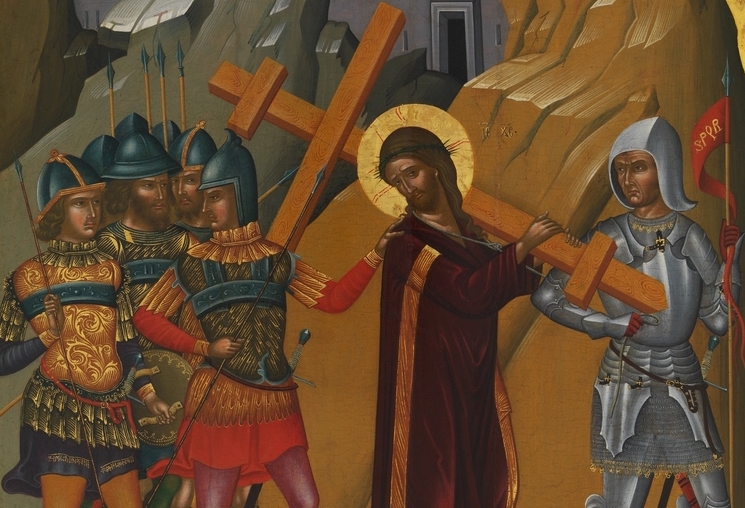In a letter from January 1926, Ernest Hemingway reflected on his unusual conversion to Catholicism. As with much Hemingway lore, the “extreme unction” he received from a priest on the battlefield in 1918 is shrouded in mystery. Although Hemingway was clear that he was “not what is called a ‘good’ Catholic,” and that he loathed being pigeonholed as a “Catholic writer,” he “cannot imagine taking any other religion seriously.”
A few months after that letter, Hemingway wrote three stories in Madrid: “The Killers,” “Ten Indians,” and “Today is Friday,” which was written entirely on May 20 and 21, 1926. The story was published in his 1927 collection Men Without Women, and remains an oddity. Hemingway’s fractured relationship with Catholicism is well-known—although he was characteristically flippant about the church and piety, he attended Mass, made pilgrimages, venerated saints—but it is rarely the subject of his fiction. Other than the meandering prayers of Catholic Jake Barnes in his novel The Sun Also Rises, “Today is Friday” is his most explicitly Catholic work, and the perfect story to understand his vision of the faith.
The story is structured as a play. The lines of the characters are punchy and pithy—representative of the dialogue in Hemingway’s more traditional fiction, but very close in cadence and style to the voice employed in his personal letters. In the story, three Roman soldiers are drinking wine the evening after Christ’s crucifixion. One soldier is later revealed to be Saint Longinus, the blind soldier whose lancing of Christ led to his conversion. They begin the story already a little drunk. Other than brief interjections from the “Hebrew wine-seller” at the bar, the narrative is entirely their conversation.
The men banter about the best type of wine, until the third soldier (none of the soldiers have names) is keeled over a barrel, with a “gut-ache.” The wine-seller gives him a concoction to “fix up his stomach.” After drinking it, he says “Jesus Christ”—leading the other characters to talk about the crucifixion. One soldier wonders why Christ did not save himself, and the first soldier’s response is strange: “He didn’t want to come down off the cross. That’s not his play.”
The conversation is already sardonic and dark. Hemingway clearly intended the back-and-forth to be colored by wine, and of course there is the absurdity of delivering these lines in speech contemporary to the 1920s. Not to mention that the wine-seller’s name is “George,” and his accented dialogue is phonetically rendered (such as calling one soldier “Lootenant”). It is tempting to dismiss the story as Hemingway goofing around.
We might dismiss it—if not for Hemingway’s continued fascination with, and sporadic devotion to, the faith. When Hemingway’s characters speak, his pages are often full of white space. Their gestures are dramatic but ambiguous. They are, to use one of his terms, “hard-boiled.” One of the elements of his literary genius was his ability to craft deliberate, precise scenes that can be read in multiple ways.
“Today is Friday” is, on its face, a farce. But it is a farce delivered with a sense of wonder. As the conversation progresses, the soldiers speak about the physicality of the crucifixion: almost a theology of nailing. The second soldier says the nailing to the cross isn’t as bad as when Christ, and others crucified, are lifted upright: “When the weight starts to pull on ‘em. That’s when it gets ‘em.” Here the soldier is certainly talking about physical pain, but he is also talking about despair. Again, the first soldier responds that Christ “was pretty good in there today,” leading the other soldier to quip “You’re a regular Christer, big boy.”
Meanwhile, the third soldier, sick from the start of the story, is sitting with his head down. He is silent while the other soldiers commend the bravery and devotion of the women in Christ’s life, saying “his gang” had “faded out. Just the women stuck by him.” The first soldier reflects on his decision to pierce Christ’s side with the lance; although he does not speak of a physical blindness, he is gaining the vision of Christ’s true identity within the story. When the third soldier does speak again, he repeats “I feel like hell.” There’s an odd convergence between present speech and past thoughts, creating a feeling of eternity to the story. Of all the Biblical narratives that Hemingway could have chosen to write a fictional sequel to, the crucifixion seems particularly apt: Hemingway was a writer of suffering, despair, and the emotions we hold in our hearts.
"Today is Friday” is suffused with a powerful emptiness—both Hemingway’s spare prose, but also the weight of what happened hours before—and it is the best evidence that Hemingway’s Catholicism, although unconventional, was a meaningful part of his literary life.
Nick Ripatrazone has written for Rolling Stone, Esquire, The Atlantic, and is a Contributing Editor for The Millions. He is writing a book on Catholic culture and literature in America for Fortress Press.
Start your day with Always Forward, our award-winning e-newsletter. Get this smart, handpicked selection of the day’s top news, analysis and opinion, delivered to your inbox. Sign up absolutely free today!

